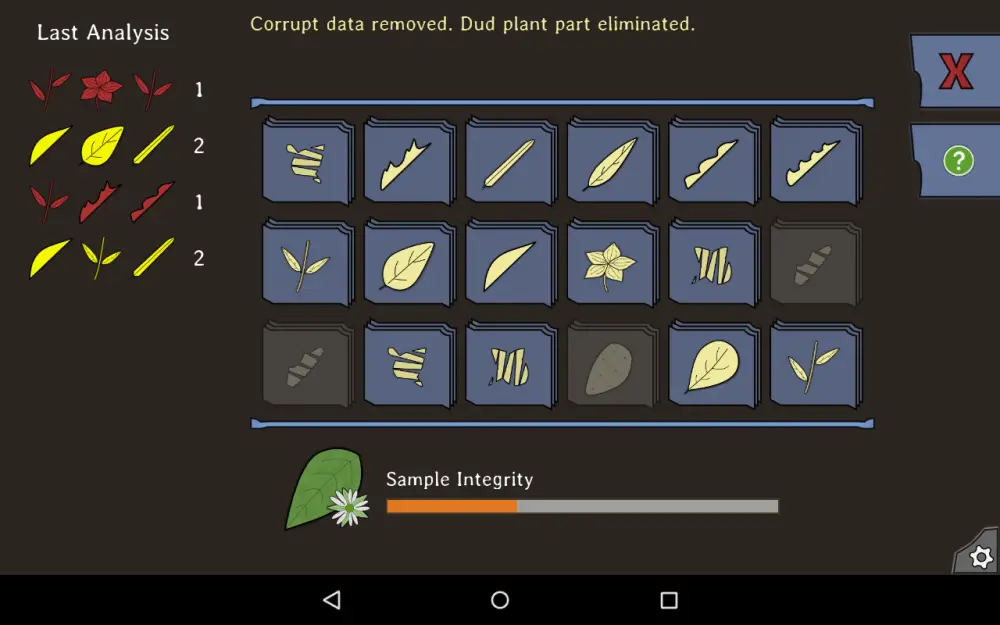Xenophyte is not for the faint of heart. Any game that asks you to spend part of your downtime identifying types of plants is asking for commitment. Those unfamiliar with Xenophyte‘s rather dense style of gameplay will find themselves frequently flummoxed when learning the ropes of the game, but in the end sticking around is a lot more rewarding than an early rage-quit. Xenophyte is a well put-together roguelike that offers challenging gameplay and a subtly unfolding story, and it will keep you coming back no matter how many times it puts you through the ringer.
Just in case you can’t remember back to that linguistics class you took, “xeno” means “alien” and “phyte” means “plant.” So, yes, this is a game about alien plants. The game’s sci-fi storyline revolves around crash landing on a distant “seed world” in need of rehabilitation so that its “seedizens” can thrive. You interact with a mustachioed AI program named Solum, who reveals the details of your crash in a piecemeal way that starts to feel mysteriously ominous.
The premise of the game is difficult to sink your teeth into on first play. Collecting and identifying plant specimens may not sound like one of the most fun Android games, and it doesn’t help that the learning curve is so steep. Xenophyte does not offer much in the way of a tutorial, and instruction is often frustratingly vague. The plant specimen identification process in particular may cause you to toss your phone across the room in abject despair on the first few tries. It involves matching three plant attributes to a newly discovered plant in a way that seems completely random until you get the hang of it. The process really ought to come with more in-depth instruction, considering it turns out to be based on the actual, scientifically accurate minutiae of plant classification.
While this heavy amount of detail is overwhelming at first, it ends up being Xenophyte‘s greatest strength. Like an optical illusion, if you stare at the seemingly meaningless dots for long enough, a beautiful picture emerges. Xenophyte‘s gameplay is incredibly rich, and increases in complexity the farther you go in the game.
The goal of the game is exploration, and there’s plenty to discover along the way. The map is laid out like a randomly generated board game, and new tiles can only be uncovered if you collect the proper number of resources. Each tile is itself another randomly generated map, to which you send a gleaner droid to uncover resources and avoid any animals or enemy droids that might be hiding.
Actions are taken via a turn-based system. You have to collect resources, clean and restore patches of the planet, and get out safely without your vulnerable gleaner droid taking too much damage. Not only do you have to explore as much of the planet as you can, but you have to protect the zones that you’ve already uncovered from neglect. Random events like wildfires or infestations of unruly droids will occur that require you to return attention to previously explored regions. To be successful, you can’t stretch yourself too thin.
It’s this element of strategy that makes Xenophyte most enjoyable. At first, it just seems overly complicated and unintelligible, as if the challenges are designed only to make it easier to die. While Xenophyte is certainly hard at times, the title’s nuanced gameplay is worth the effort once you figure out how everything works.
Xenophyte would definitely benefit from a tutorial, or reference guide, as its dense interface and complicated gameplay are not easy to learn on your own. But once you get into the swing of it, you’ll be having more fun collecting plants than you ever thought possible.
Hardcore?
Yeah.
Too complex to be accessible to the casual players and occasionally difficult to a fault, Xenophyte remains a rewarding roguelike, once you get the hang of it.






























